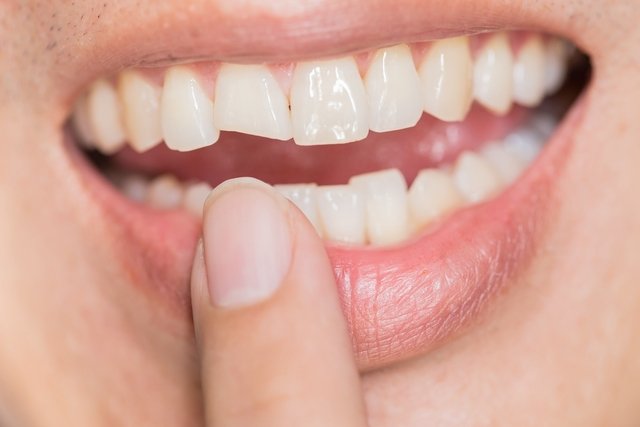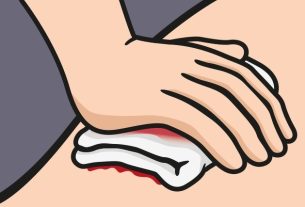A broken or cracked tooth can be caused by trauma to the tooth due to falls, blows or accidents, or by eating hard foods, bruxism or cavities, which can affect the crown or root of the tooth.
Depending on its cause, a broken tooth may be accompanied by other symptoms, such as bleeding gums, toothache, changes in chewing, for example, although in some cases it may not cause other symptoms.
A broken tooth should always be evaluated by a dentist, but you can take some precautions until the appointment, such as placing gauze soaked in cold water over the tooth or rinsing your mouth with water and salt.

Broken tooth symptoms
The main symptoms of a broken or cracked tooth are:
- Toothache when chewing or eating very hot, cold or sweet foods;
- Toothache that comes and goes;
- Swelling in the gums around the tooth;
- Presence of a vertical line on the affected tooth;
- Tooth discoloration.
In some cases, a broken or cracked tooth may not cause symptoms, or you may even notice visually that a piece of the tooth or a line in the tooth is missing, especially when it happens in the front teeth.
The broken or cracked tooth must be evaluated by the dentist who can indicate the most appropriate treatment.
Possible causes
A broken, cracked or chipped tooth can be caused by cavities, blows, knocks or accidents to the tooth, or by chewing very hard foods, such as hard candy, ice or nuts, for example.
Other causes of broken teeth are bruxism or fillings that are too large which can cause the tooth to weaken, which increases the risk of cracks and fractures.
Tooth broken by cavities
The decayed tooth can become more fragile, which increases the risk of fractures or cracks in the tooth.
Tooth decay can be caused by poor oral hygiene, which can result in the formation of bacterial plaque that affects tooth enamel, leaving it weaker. Understand better what cavities are and how to identify them.
What to do if you have a broken tooth
If you experience bleeding when you break a tooth, you should:
- Place a gauze pad soaked in cold water on the affected tooth or rinse your mouth with cold water;
- Placing an ice cube on the affected area or eating a popsicleafter stopping the bleeding, to prevent swelling of the mouth.
- Apply cold compresses to the face on the side of the broken toothin order to reduce or prevent swelling;
- Do not use mouthwash because they can worsen bleeding;
- Avoid using a toothbrush over the area of bleeding.
Furthermore, if the person has a toothache, they can take an anti-inflammatory or analgesic, such as paracetamol or ibuprofen, for example.
In all cases, you should consult your dentist as soon as possible or go to an emergency dental care service..
Is it possible to fix a broken tooth at home?
It is not possible to fix a broken tooth at home, and it must always be fixed by a dentist, as it can cause complications if left untreated, such as infections or oral diseases.
Therefore, when you break your tooth, you should consult your dentist as soon as possible to have the affected tooth treated.
How to store a piece of broken tooth
Some ways to save a broken tooth to take to the dentist are:
- Wash the piece of tooth or the entire tooth with warm water only;
- Place the piece of tooth in a glass of cold milk or in a container with the person’s own saliva;
- Leave the entire tooth inside the mouth, in the case of adults, to make it viable for reimplantation, which should happen within a maximum of 1 hour after the accident.
Then, you should immediately go to the dentist or an emergency dental service, so that the treatment can be carried out quickly and you can be able to reimplant the affected tooth. See how dental implants are performed.
How the treatment is carried out
The treatment of a broken or cracked tooth is carried out by the dentist, and varies according to the severity and extent of the tooth fracture.
1. Regular consultations
In the case of small cracks in the tooth, which form a small thin line on the tooth, the dentist may only recommend regular appointments.
This is because this type of injury affects the external enamel of the tooth, being a superficial crack, which can only cause aesthetic discomfort and does not cause pain.
2. Paste the fragment
In some cases, the dentist can glue the fragment of the broken tooth together after cleaning and properly preparing the affected tooth.
3. Filling
Tooth filling is generally indicated when there is a cavity or to treat a broken or cracked tooth that is not decayed.
This type of treatment is done by removing the part of the tooth that is damaged, cleaning and preparing the tooth and then placing a resin to restore the function and shape of the tooth. This resin has the same color as the tooth, giving it a natural appearance.
In cases of teeth with deep cavities that affect the nerve, treatment is done through endodontics, also known as root canal treatment, to reconstruct the resin or place a crown. See how root canal treatment is done.
4. Tooth polishing
Tooth polishing is one of the treatments for a tooth with a small fracture or slight crack.
This type of treatment is done by wearing down the affected tooth a little where it is broken or cracked and then polishing it to make it smooth.
5. Placing a crown on the tooth
Placing a porcelain or ceramic crown on the tooth serves to replace the broken or cracked natural dental crown.
This type of treatment involves a small amount of wear on the tooth enamel and, subsequently, the removal of a mold of the affected tooth to create the dental crown prosthesis, which can take a few weeks.
When the dental crown is ready, the dentist applies dental cement to fit the prosthesis into place.
6. Tooth extraction
Tooth extraction, known as extraction, is indicated in cases where the broken tooth has a badly damaged root, nerves or other structures, making it impossible to recover the tooth. See how tooth extraction is done.
Broken baby tooth
If a baby tooth has broken and come out completely, there is no need to place another tooth in its place as the loss of a primary tooth does not cause any change in the position of the teeth or difficulties in speaking. And at the correct stage, the permanent tooth will emerge normally.
But if a child loses a tooth in an accident, long before the age of 6 or 7, it is important to assess with the dentist whether it is worth using a device to keep the space open for the permanent tooth to emerge easily.
How to restore a broken tooth
Treatment to restore a broken tooth will depend on which part of the tooth is broken.
When a permanent tooth breaks below the bone line, the tooth is usually extracted and an implant is placed in its place. But if the permanent tooth has broken above the bone line, the tooth can be devitalized, reconstructed and fitted with a new crown.
If the broken tooth only affects the tooth enamel, the tooth can only be reconstructed with composites. Find out what to do if your tooth is crooked, stuck in the gums or becomes soft.
Does a broken tooth grow back?
The broken tooth does not grow back, and it is necessary to consult the dentist so that the most appropriate treatment can be carried out to restore the tooth. In cases where the broken tooth was a baby tooth, it is normal for the permanent tooth to emerge, however this birth is a natural process and is not due to breakage.
When to go to the dentist
It is recommended to consult your dentist whenever:
- The tooth is cracked, broken or out of place;
- Other changes appear in the tooth, such as a dark or soft tooth, up to 7 days after the fall or accident;
- There is difficulty chewing or speaking;
- Signs of infection such as swelling in the mouth, severe pain or fever appear.
In these cases, the dentist will evaluate the location of the affected tooth and diagnose the problem, starting appropriate treatment.

Sign up for our newsletter and stay up to date with exclusive news
that can transform your routine!
Warning: Undefined array key "title" in /home/storelat/public_html/wp-content/plugins/link-whisper-premium/templates/frontend/related-posts.php on line 12
Warning: Undefined array key "title_tag" in /home/storelat/public_html/wp-content/plugins/link-whisper-premium/templates/frontend/related-posts.php on line 13



